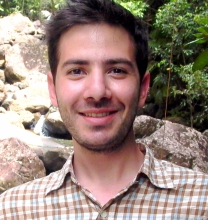CEE Seminar: Coupled Physically-based Modeling of Rainfall-triggered Landslides & the Influence of Soil Erosion on the C Cycle in Diverse Critical Zone Observatories

Postdoctoral Scholar
Efi Foufoula-Georgiou Group
Civil & Environmental Engineering
UC Irvine
Abstract: Globally, there is an inseparable relationship between hydro-climatic phenomena, land surface processes and carbon (C) dynamics. Elucidating complex interrelations between climate, vegetation, soils and anthropogenic activity is critical for understanding future challenges posed by climate change.
To quantify risk of rainfall-triggered landslides at the watershed scale, a natural hazard with thousands of casualties annually and billions of US dollars in infrastructure damage, a probabilistic approach for coupled physically-based hydrological-slope stability models is presented. The framework was implemented in the tRIBS -VEGGIE model (Triangulated Irregular Network-based Real-time Integrated Basin Simulator - VEGetation Generator for Interactive Evolution). It is demonstrated that the natural spatial variation of soil hydrological and geotechnical properties greatly influences the timing and magnitude of landslides triggered by tropical storms. Landslide risk in contrasting landscapes in northeastern Puerto Rico is expected to remain significant in the 21st century, despite a projected precipitation decline.
To assess the critical influence of soil erosion and organic C burial on the terrestrial C cycle, a spatially-explicit model of soil organic C (SOC) dynamics is introduced, coupled with a physically-based hydro-geomorphic model (tRIBS-ECO). The Calhoun Critical Zone Observatory (SC) is studied, which has experienced some of the most serious agricultural soil erosion in North America, and the Luquillo Critical Zone Observatory (Puerto Rico), a tropical site of particular ecohydrological and geomorphological interest. This study demonstrates the substantial topographic variability in the redistribution of SOC as soil erosion and deposition proceed.The capacity of diverse landscapes to act as a net atmospheric CO2 source or a sink in response to hydro-geomorphic perturbations is highlighted.
Bio: Yannis Dialynas is a postdoctoral scholar in the research group of Prof. Efi Foufoula-Georgiou (UCI Dep. of CEE). He received his Ph.D. degree in hydrology and water resources engineering at Georgia Institute of Technology in 2017 under advisement by Provost Rafael L. Bras, his M.Sc. in civil engineering at Georgia Institute of Technology in 2013, and his B.S. in civil engineering at the National Technical University of Athens in 2011.
Dialynas is a 2016 NASA Earth & Space Science Fellowship recipient, a member of the American Geophysical Union’s Ecohydrology Technical Committee, and a coauthor of the 2nd State of the Carbon Cycle Report published in 2017 by the U.S. Global Change Research Program.
Share
Download
Upcoming Events
-
MSE 298 Seminar: Mechano-Electrochemical Phenomena at Ceramic Electrolyte Interfaces
-
MSE 298 Seminar: Innovation In Materials Science - An Industrial R&D Perspective
-
MSE 298 Seminar: Understanding the Impact of Grain Boundary Inclination on Grain Growth Using Modeling and Simulation and Experiments
-
EECS Seminar: Mixed Conductors for Bioelectronics
-
MSE 298 Seminar: Ionic Correlations in Polymer Nanostructures - From Block Copolymers to End-Charged Blends
